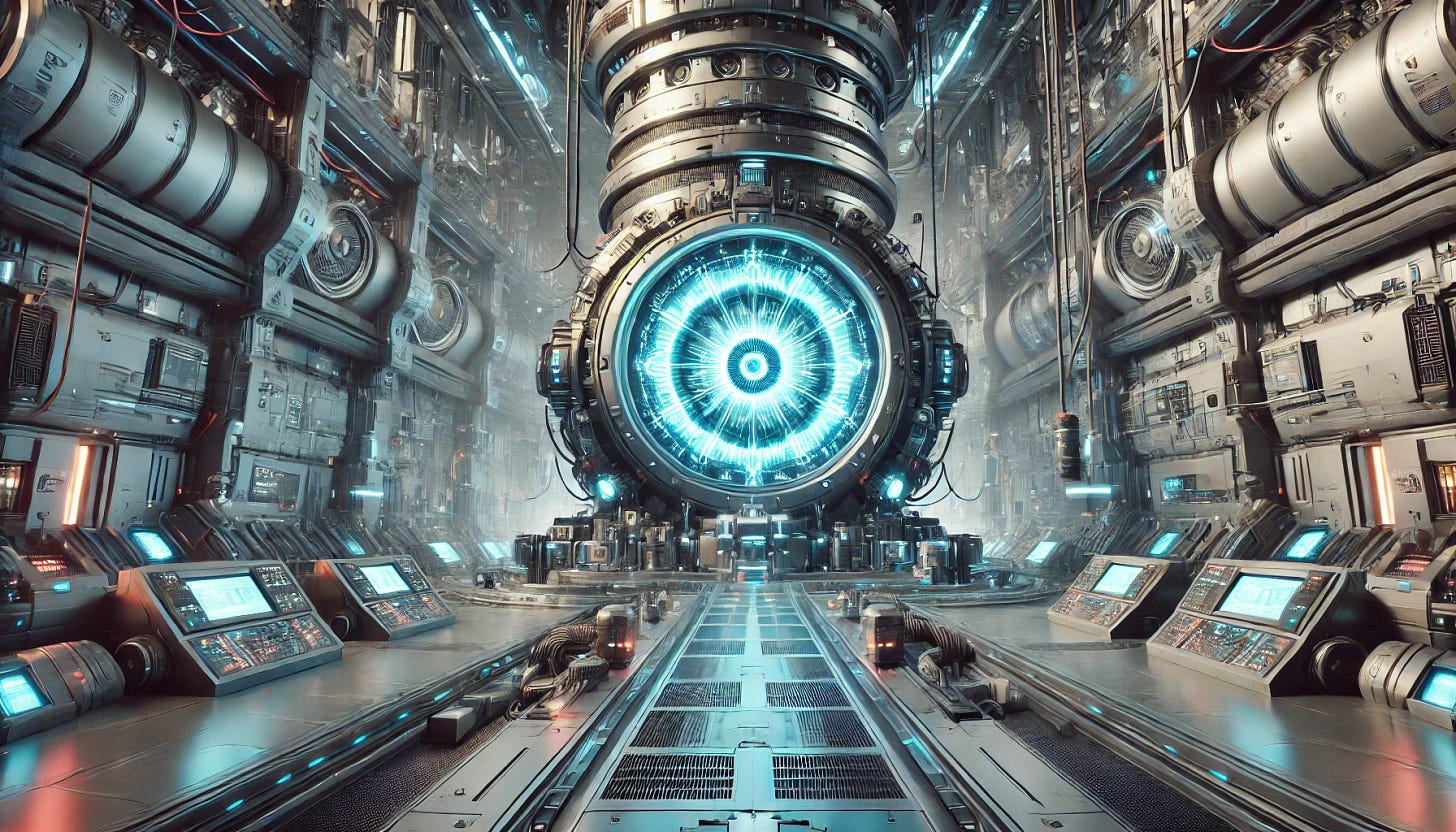✈ A quick note: I will be traveling through the middle of the month and will be posting a bit less than usual and perhaps a bit shorter than usual.
After decades of resistance to nuclear power, growing concern over climate change, rising electricity needs, and a desire for greater energy independence are spurring renewed public interest in a future powered by atomic fission (perhaps fusion, too). Today on Faster, Please! — The Podcast, I talk to Dr. Mike Goff about the state of US nuclear power, the developing advancements in nuclear technology, and what it will take to reach our vast potential.
Goff is the acting assistant secretary and the principal deputy assistant secretary for the Department of Energy’s Office of Nuclear Energy. He previously spent over 30 years at Idaho National Laboratory, including a major advisory and management role. He has written over 70 publications on the nuclear fuel cycle.
In This Episode
Atomic Age 2.0 (1:31)
Major concerns (7:37)
Out of practice (11:04)
Next-generation policy (17:38)
Human capital (21:48)
Fusion forecast (23:12)
Below is a lightly edited transcript of our conversation
Atomic Age 2.0 (1:31)
The Energy Secretary recently spoke about adding a lot more nuclear capacity, tripling it, I think, by 2050 or so. And before we get into whether that's possible, I wanted to ask you: As you understand it, what is the current consensus explanation for why the Nuclear and Atomic Age of the ’50s and ’60s, why that kind of ended? Because when the secretary spoke about building more capacity, I thought about the — and this is something maybe a lot of people are unaware of, that President Nixon had a plan to build a lot of more nuclear reactors in this country back in the ’70s during the oil crisis; that didn't happen, and we all know about Three Mile Island. But is there a consensus as to why Atomic Age 1.0 came to an end? Obviously we still get a lot of energy from nuclear, but not what people had imagined 40 years ago.
There are a variety of reasons. We did build a lot at one point, and we were building 10 plants a year, pretty extensive builds out there. We did then have Three Mile Island in the late ’70s, and then we got costs started going up, and schedules started increasing on the builds, and we ended up not having a lot of energy growth, in fact, we went for a long period where we weren't having a lot of energy growth, and we had a lot of other energy sources, natural gas, coal, and all. We had a lot of other energy sources out there as well. So yeah, we became pretty stagnated around 20 percent of the electricity. But now, like you say, yeah, there's been a big change in what we think the needs are for nuclear going forward, for a variety of reasons.
My background is journalism, and as a journalist I’ve written, I know, multiple stories in my life about a Nuclear Renaissance. So I'm wondering why this time looks to be different. You suggested in your previous answer that there might be some reasons. What are those reasons that we may be entering a new age where we will see an expansion in the nuclear sector?
I do think we will see that expansion, and, in fact, I think we have to see that expansion, and it's because of a lot of the positive attributes of nuclear right now. Obviously there's a lot of focus on trying to get more clean energy out there, and nuclear is a large base load source of clean energy. And it's not just CO2 emission, but it doesn't emit particulates and all, as well, so it's good air, good quality of life. So it has those key attributes. But there are other clean energy sources as well: renewables, hydro, and all that. But I think the recognition that, if you are going to go toward decarbonization, you need still base load electricity too. You need base load electricity to help intermittent sources like renewables to be able to expand more as well. So nuclear is very good at enabling decarbonization, not just by adding clean electricity to the grid, but enabling you to expand out other renewables like wind and solar and all, as well.
Additionally, nuclear is very reliable. Of the energy sources, it has the highest capacity factor of any of the energy sources. In the United States, we run 93 percent of the time, so the existing fleet that we have out there of 94 plants, they're producing a 100 percent of the power 93 percent of the time, which dwarfs what any other energy source does out there as well.
Nuclear is safe. At times people are concerned about safety, but, in reality, it's actually one of the safest energy sources out there and continues to demonstrate that.
It's resilient for different weather-related events. It can still produce electricity out there as well. It also has a lot of energy security. And as we've learned, unfortunately, from Russia's unprovoked and unjustified invasion of Ukraine, we recognize energy security is national security, so nuclear really does help us on that national security front. It provides an energy source that we can largely on-source from us and our allies. We’ve got assured fuel supplies, and provides that long-term power. You can put fuel in it and it can last for two years or so.
And I guess one other thing I'll add out there as well, is it's a job creator. Of the different energy sources, the amount of jobs associated with nuclear are some of the highest on the amount of electricity produced. And when you actually start building nuclear, like we saw in Vogtle in Georgia where they were building the two plants, it creates huge amounts of jobs. In fact, I heard a stat recently that 35,000 union workers were trained as part of the construction of the Vogtle power plant, so it's a good job creator in all, as well. And again, the power density is great, it doesn't take up a lot of space, and with the advanced technologies that we've developed in the United States, you've continued to increase in the safety, you can have plants of a variety of different sizes that can be easily deployed to, say, retiring coal plants. It just has a lot of flexibility that it hasn't had in the past, but also it's that key recognition of its clean energy attributes, but its energy security attributes as well.
Major concerns (7:37)
I did not major in nuclear science, I majored in history and political science, but I remember I took a class as an undergraduate at Northwestern University on the nuclear fuel cycle, and I remember to this day that my professor — of course, this was obviously a while ago, and I think what most of the students knew about nuclear energy was probably Three Mile Island — and I remember to this day distinctly the professor saying, “If they wanted to build a nuclear reactor in my backyard, I would be totally fine with it.” He had zero fear on the safety issue. Now when you give that rap that you just gave me about the wonders of nuclear energy before regular people, what is their response? Do they worry about the nuclear waste? Do they worry about safety? Are they immediately sold, or what are the concerns that typically get raised to you?
You brought them up. I mean, safety is brought up because you do see these high profile accidents like Three Mile Island, Chernobyl, Fukushima, which were accidents. They weren't good things that you want to have happen, but the industry's also a very learning industry. The improvements that come out of those events have just made the industry even safer and safer. And again, it's still safer than most any other electricity-producing industry out there as well.
Waste does get brought up. We have not implemented a final disposal solution for the spent fuel from our reactors, but we have safely stored and managed the spent fuel over the last six decades, and the amount of fuel that's generated, I think the stat that gets tossed around, you could fit it all in a Walmart parking lot. This is not a lot of material because it's a high energy-density fuel. It's not a lot of material, and again, we safely manage that and store that. We have countries now that are moving forward with geological repositories, which we need to be doing in the United States. In fact, just last week, I went and visited the repository that hopefully will be operating next year in Finland for disposing of their spent fuel. We can do that, it’s not a technical issue, so we can safely manage the spent fuel.
The other issue that always comes up is still cost. We do have to demonstrate now that we can build these plants safely, and efficiently, and at a reasonable cost. On the Vogtle plant there were cost overruns and schedule overruns, but between Vogtle Unit 3 and Unit 4, there was about a 30 percent reduction in costs between those plants, so we are starting to get to where we can be deploying nth-of-a-kind cost plants out there as well. And hopefully with some of the small modular reactor designs and all that are going to rely more on modular construction, we can even get to nth-of-a-kind cost even quicker. It still takes some pushing and understanding to make sure that people do understand the advancements that have been made on nuclear technology, that it's not our parents' nuclear technology, there's a new round of technology out there.
Out of practice (11:04)
You raised two good points there. The cost issue, and that's a great stat about the Vogtle plant and the reduction between the two reactors. Is it your sense that the fact that we haven't been consistently building reactors and learning from the previous build, and having trained people who've worked on multiple reactors, that each one has become like this bespoke mega project? It’s my sense, and it seems logical, at least to me, that that has been a cost driver, that we haven't been able to churn these out like 10 a year, every year, decade after decade, because clearly, if that was the case, I don't see how we don't learn how to build them better, faster, and more efficiently. But that's not what we've been doing, obviously.
That's right. It's not. Even when I say with Vogtle, you had to stand back up the whole supply chain, you had to retrain the workforce, so there was a lot of learning in that process, even though, too, we did recognize on that plant you need to have designs very well finalized and standardized as well. One of the problems we realized from the buildout of the 90-something plants that we have now is no two plants were ever that similar. Everyone wanted to make a tweak in their plant, so we never got to where we had standardized designs.
So I think now that we're getting that trained workforce, getting the supply chain up there, and our vendors are really saying, “We're doing standardized plants. If someone else wants to make a tweak on this plant, they have to go somewhere else,” that people are going to go with standardized designs so we can really replicate these and get that cost benefit from it. The challenges that you brought up, we have to overcome, and I think we're set up now to be able to overcome that. I appreciate all the effort that went into building Units 3 and 4 at Vogtle. We've got enough benefit from that learning there and hopefully build very soon here.
There's a world where we have tripled our nuclear generating capacity, as Secretary Granholm said. Can that be a world where we get all our nuclear power from light water nuclear reactors, or must there be different kinds of reactors? You mentioned the small modular reactors, and I've interviewed startups doing microreactors, I don't know, maybe they'll be used to power data centers, but can that world of greatly increased nuclear generation, even with improvements in light water reactors, must there be different kinds of reactors?
I wouldn't say “must.” I think there will be. I think we will have that variability. I think we will still have large plants being built. I think maybe five years ago you wouldn't hear that people were talking about building gigawatt-sizes plants again. I think we'll have the gigawatt-size plants, we'll have the small modular reactors that are water-cooled, but I think we will get some of those advanced reactors out there: the Generation IV reactors, the sodium-cooled fast reactors that have the capacity to be able to burn waste better and also increase the sustainability of the amount of fuel they use. I think you’ll also have the high-temperature gas reactors that are helium-cooled, that use TRISO fuel. You'll have those because we need to not only decarbonize the electricity sector, we've got to decarbonize the industrial sector. That's much more challenging, and the high temperatures that can be provided from those reactors will help us in that decarbonization process.
So I think we will have a mixture out there. There are cases where the Gen IV systems are going to be better than the gigawatt-sized plants for the needs that are out there, but large power plants are going to be needed as well. Especially, like you say, you bring up the data centers, the amount of growth that we're hearing for electricity right now, I think again, we'll see gigawatt-sized plants will be needed to be able to meet that growth.
Yeah, I tell you, nothing frustrates me more than reading about what AI could perhaps do for our economy and then having people say, “Well, but we know we can't do it because we can't supply the power” or “We can't supply enough clean power,” I mean, well then it’d be sure great to have more nuclear energy. And I wonder, as you sort of tick off some of the potential advances and new kinds of reactors, maybe I look backward too much, but I can't help but wonder what nuclear reactors would be like today, where we would be today, maybe we would already have fusion reactors had we proceeded with this kind of momentum every decade since 1980. It drives me crazy, and you're a nuclear engineer, that must drive you crazy.
It does, I've been doing this . . . my first job in the nuclear industry was almost 40 years ago when I was still in college, and there have definitely been ups and downs in funding. In fact, there were some periods where there was almost zero research and development dollars spent in the government on nuclear energy. Luckily, though, the thing that we have is, under the four presidential administrations, there's been a real steady climb in the recognition of the importance of nuclear, and the funding to support it. So I'm happy that we have had this period that goes back to the early 2000s that's been really steady growth in recognition of nuclear. If we would've not had some of those laws in the late ’80s and ’90s, yeah, we could probably be further ahead, especially on some of the advanced technologies. Because yes, some of those advanced technologies started on research that was back in the ’50s, ’60s and ’70s: the sodium-cooled fast reactor, the molten salt reactor, all of those were based on R&D that we did back in the early days, as well.
Next-generation policy (17:38)
Which leads me to this question: You work for the government. I work for a public policy think tank, so of course I'm going to think about: Given where we are today, what government needs to do going forward, both on the R&D front and on the regulatory front, are we doing enough basic research for whatever the next, or the next next generation of nuclear is, and do we now have the kind regulatory framework we need for that next generation of reactors?
I'll go to the research one first—and I should note, my background is, I'm an R&D person, I came out of the national labs, so of course we always need more research and development. But that said, we have been blessed by funding from Congress and the administration that there's a significant amount of money for research and development in the United States. And I'll say that's good, because the one thing I will note, I do believe innovation in the US, as far as the nuclear technology, we are the best. The technologies that we're developing and our vendors are deploying it, really, it is the cutting edge technology, so it's good we have that R&D, and it's important, as you know, we need to continue to have it to move forward on that next generation of technologies and continue to make improvements on the technologies out there. So I think we have a good research base.
There's some infrastructure that we still need if we start deploying, say, when we mentioned that sodium-cooled fast reactor, we don't have a testing capability for that type of system. We shut down our last testing system on a fast reactor in 1994. We would probably need some additional infrastructure. But again, we have a pretty good base. And I'll say that also on the regulatory side. We do have a pretty good base as well. The Nuclear Regulatory Commission is obviously focused on light water reactors throughout its history, but they've actually been doing a good job at being able to work with some of the developers.
We have three entities out there that are working on Generation IV reactors. TerraPower did submit their construction authorization to the Nuclear Regulatory Commission, and they've accepted it, so they're working well with them, even though they have a water-based system. Hopefully X-energy, who's doing a high-temperature gas reactor, working with the government and all, as well, will be moving forward, as well. And we've had a third that's working in the molten salt space, a molten salt-cooled reactor that has already received a construction permit to go forward on a prototype reactor, a Kairos company.
I'm sure there's got to be reforms still on the Nuclear Regulatory Commission and make sure that we are timely and responding to license applications, but they are moving in the right direction. There's been a lot of interface with various laws, whether it's the NEICA (Nuclear Energy Innovation Capabilities Act), or NEIMA (Nuclear Energy Innovation and Modernization Act), two bills that were passed a little while back looking at reforming. And I think there still needs to be improvements and still need to be increase in the resource and capacity of the Nuclear Regulatory Commission, but they're heading in the right direction.
We have a good regulator, and that's one of the things that helps us make sure we feel that we can deploy this technology safely here, but also helps us in exporting our technology, where we can say, “Our technology has been licensed by the Nuclear Regulatory Commission,” which has such a high view externally in other countries, that helps us. So I want them to continue to be that safe regulator, but again, they are continuing to work to improve and streamline the process. Hopefully we get toward where we're standardizing, that we don't have to have a lot of interface and we don't — that'll come to the utilities, too — we don't make changes once we've got something approved, so we hopefully can speed up the process from the utility side, and all is well.
Human capital (21:48)
Are we going to turn out enough nuclear engineers? I imagine that, for a while, that probably seemed like a hard sell to someone who had an interest in science and engineering, to be in this industry versus some others. Probably a little easier sell; are we going to have enough people going into that to build all these reactors?
We are going to need to continue to increase it. We’re already seeing the uptick, though, in that area. I'll note: Our office, the office of Nuclear Energy, we've really — going back to the 2010 timeframe — really recognized that we needed to do more in that area, so we actually started investing almost 20 percent of our R&D budget to the universities to hopefully foster that next generation. And in fact, this year we just hit the mark where we've now spent $1 billion since the start of those programs on the universities to make sure we're doing R&D there and getting that next generation of folks out there. It’s something that we've got to continue to focus on to make sure that we do. Because yeah, if we triple, it's going to need a lot more nuclear engineers. But I also note, the thing I'm concerned about also is making sure we have the right trades and all, as well. If we're building these plants, making sure you have the welders, the pipe fitters, and all, that's going to be a big challenge, as well, especially if we're going to start building, say, 10 plants a year. That's a lot of people out there.
Fusion forecast (23:12)
I’m excited about the prospects for nuclear fusion, and I've talked to people at startups, and it has probably looked as promising as it ever has. How promising is it? How should I think about it as being part of our energy solution going forward, given where we're at? In fact, there are no commercial nuclear fusion reactors right now. Obviously people at startups give a lot of optimistic forecasts. How should I even think about that as being a partial solution in the coming decades? How do you look at it, at least?
I think it can be part of the solution in the coming decades. I think some of the changes that's taken place, especially over the last two years where there is more of a change to focus on, not fusion as a science program, but fusion as deployment, as an energy producer, you look at it as an applied energy. I think that's an important change that's occurred over the last two years, and the fusion programs within the Department of Energy are much more focused to that. It's similar to what's happened somewhat with fission. Fission, about 15 years ago, it was government-driven, and you pull along industry, until about 15 years ago you started having industry investing a lot of money and pulling along the government. You're now starting to see that happen in fusion, where people are doing a lot of a private investment, they're pulling along the government, and the government's working to see, how can we use the resources of the government to enable it?
So I think it will happen. I don't think fusion is going to be producing electricity to the grid this decade, but I think the vision that's been put forth by the government is their bold, decade-old vision to have a fusion pilot facility sometime within the decade. I think that is feasible. So maybe before the 2050s you can start having fusion generating some of our electricity. I'm a fission person at my heart, but I think fusion is, we're getting much more focused on moving it forward as an electricity source, and that'll help it be able to be deployed sometime here in our lifetime.
Micro Reads
How Elon Musk and SpaceX Plan to Colonize Mars - NYT
What happened to the artificial-intelligence revolution? - Economist
The EV trade war between China and the West heats up - Economist
Defeated by A.I., a Legend in the Board Game Go Warns: Get Ready for What’s Next - NYT
Pfizer pins hopes on daily pill to crack market for weight-loss drugs - FT
Rise of the Restaurant Robots: Chipotle, Sweetgreen and Others Bet on Automation - WSJ
Saudi Arabia's Trillion-Dollar Makeover Faces Funding Cutbacks - Bberg
AI Spending: Goldman Strategists Say Big Tech’s Splurge Worries Investors - Bberg
It’s Time for AI to Start Making Money for Businesses. Can It? - WSJ












